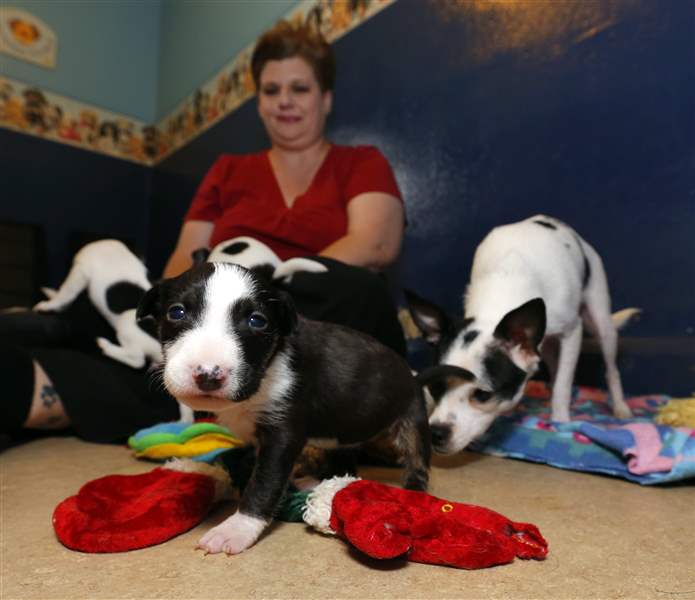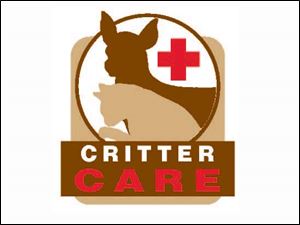
CRITTER CARE
Breeding dogs can be more difficult than some anticipate
9/9/2013
Mona Guinaugh spends time with foster dogs Candy Crush, center, and Adele, right. Adele added Candy Crush to her brood of nursing pups after Candy Crush’s mother wouldn’t nurse her.
The Blade/Andy Morrison
Buy This Image

Mona Guinaugh spends time with foster dogs Candy Crush, center, and Adele, right. Adele added Candy Crush to her brood of nursing pups after Candy Crush’s mother wouldn’t nurse her.
Things don’t always go as planned when dogs have puppies.
Such was the case with Delilah, a pregnant bull terrier who was transferred from the Lucas County Dog Warden to Planned Pethood, a local rescue group.
The dog had one puppy and after less than a day, her foster caretaker, Amy Gill of Toledo, observed that she was not nursing. The puppy, named Candy Crush or CC for short, was taken to SylvaniaVET where Dr. John McCarty determined she was dehydrated. She spent two days in the vet hospital, receiving IV fluids and other care.
As luck would have it, another Planned Pethood foster, Mona Guinaugh of Toledo, had taken another pregnant female dog from the Lucas County Dog Warden about two weeks before Delilah was transferred. The black-and-white Chihuahua, named Adele, had three puppies and was nursing the crew with no problem.
When CC was released from the hospital, she was going to need round-the-clock bottle feedings by her foster mom.
That is, unless Adele wouldn’t mind adding another puppy to her brood. The 3-day-old puppy joined the group and has never looked back.
“Adele took to CC and vice versa,” Ms. Guinaugh said. “Because of the more than 2-week age difference, Adele was adjusting her litter's feeding schedule to their age. So every three to four hours, I laid on the floor of the puppy room to monitor and encourage Adele to feed CC.”
The Chihuahua mom didn’t mind the scrawny little newcomer in the least, she said.
“Adele was a champ,” Ms. Guinaugh said. “We only had to bottle feed CC on very few occasions. CC is gaining weight daily and will no doubt weigh more than Adele's puppies in no time.”
CC is now 3 weeks old and her Chihuahua siblings will be 6 weeks old on Tuesday. CC weighs about the same as one of the puppies, whose name is Aloha.
“They are best buddies,” Ms. Guinaugh said.
Planned Pethood normally spays or neuters and vaccinates puppies when they are 8 weeks old as long as there are no medical issues and they go up for adoption. But in this case, the Chihuahua puppies will wait for their adopted sibling to hit the 8-week mark.

“In order for CC to receive the optimum socialization, Adele's puppies, named Arctic, Aloha, and Aussie, will not be getting vetted and offered for adoption until CC is old enough for the same,” Ms. Guinaugh said. “They will all be kept with me until they are adopted out. Delilah was medically cleared for adoption and was spayed. She is listed on our Web site now.”
Breeding dogs and having puppies is more work than most people realize.
Dr. Bob Esplin at SylvaniaVET says employees at his practice frequently get the question of who should breed their dog.
“In the most basic terms, we recommend that only purebred dogs should reproduce,” he said. “In addition, we feel that all dogs that are being bred be great representatives of the breed. This means they have great conformation, a breed appropriate temperament, and no known problems like allergies, hip dysplasia, or epilepsy.”
He does not recommend breeding mixed-breed dogs.
“Breeders of hybrid dogs, such as Labradoodles, would have you think they are purebred,” he said. “Until these dogs can be registered with the American Kennel Club and shown at sanctioned shows, one must think of all these designer pups as mixed breed dogs.”
Many times he hears that an owner wants to breed so they can get another dog just like the one they have.
“This is not a realistic goal and a poor reason to bring a litter of puppies into the world,” he said. “Remember, you must be responsible to find homes for the entire litter. If you desire another dog of the same breed we recommend you buy one. This enables you to time the purchase and pick a puppy that appeals to you.”
Breeding is a lot of work and a lot of responsibility with the potential of a lot of expense before you can sell even one puppy, he said.
The American Kennel Club advises that raising puppies is a full-time job, according to an article on the group’s Web site “A Guide to Breeding Your Dog.”
“During the first couple of weeks the dam normally takes care of the puppies' needs, but complications, such as a dam with no milk or an orphaned litter, may arise,” according to the guide.
Puppies are even more work when they are weaned. The extra feeding, cleanup, grooming, training, and veterinary care adds up to a lot of hours.
“Another factor that you must consider is the financial cost of having a litter of puppies,” according to the AKC. “From the genetic screening and health tests before breeding to the extra food, supplies, and medical care required after the puppies are born, the cost of whelping and raising puppies can be very high.”
Planned Pethood is always in need of foster volunteers to care for animals awaiting homes. For more information on volunteering, go to tinyurl.com/fosterPPI or call 419-826-3499 or email pets@plannedpethood.org
Contact Tanya Irwin at tirwin@theblade.com, 419-724-6066, or on Twitter @TanyaIrwin.